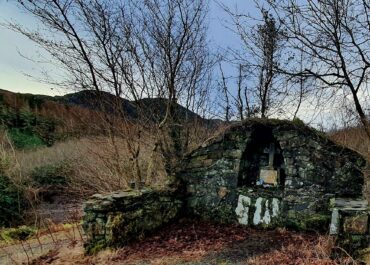Graveyard, Clonca, Co. Donegal
In the townland of Clonca in County Donegal, the ruins of a 17th-century church stand within an ancient graveyard, incorporating fragments from much earlier ecclesiastical buildings.
Graveyard, Clonca, Co. Donegal
The rectangular gabled church, built sometime after 1622 and used until 1827, measures about 14 metres by 6 metres internally and remarkably still stands to its original height. The eastern gable is crowned with a small stone cross, whilst the walls, constructed from rubble and split stone with ashlar quoins, contain several intriguing reused elements; some blocks feature small chamfers and roll-moulded edges that likely came from an earlier medieval church or memorial stones on the site.
The church interior houses several remarkable carved stones that speak to centuries of craftsmanship and devotion. Most notable is the ‘Magnus and Fergus’ grave slab, measuring 1.85 metres long and decorated with a cross, foliage, a sword, and curiously, a playing stick and ball. Its inscription reveals it was made by Fergus Mac Allan for Magnus Mac Orristin, dismissing old tales that suggested it was brought from Scotland. In the southwest corner sits a portable bullaun stone, whilst built into the northwest exterior wall is a stone bearing a mallet and chisel device with a partially legible inscription mentioning O’Dubdagan and Domnall.
The field west of the graveyard contains two impressive high crosses that showcase the sophistication of early Irish stone carving. The larger cross, standing nearly 4 metres high and carved from a single slab, displays extraordinary detail including interlace patterns, kneeling animals with wedge-shaped faces, seated figures, and what appears to be a depiction of the miracle of the loaves and fishes, complete with a figure holding a plate with five small ‘buns’ arranged in a cross pattern. The second cross survives only as a ringed head decorated with triquetras, concentric circles, and eight coils connected by C-curves arranged in cruciform fashion. Nearby, a boulder with a carefully cut socket likely served as the base for one of these monumental crosses, whilst a holy well in the neighbouring field and traces of an ancient tochair (roadway) across the nearby bog remind us that Clonca was once a significant stop on medieval pilgrimage routes through Donegal.


